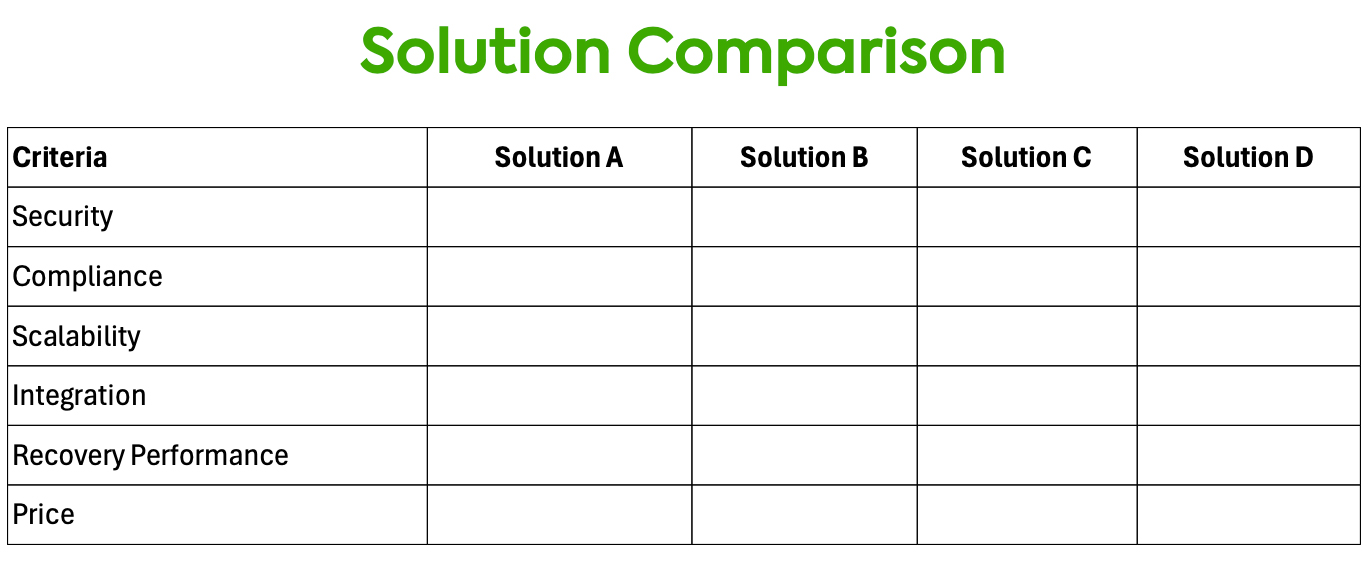By Steve Snook, Cloud CTO at Securecom
Background
After two decades in IT, I’ve seen data protection evolve from tapes in a cupboard to complex, hybrid-cloud solutions spanning multiple platforms. But with more choice has come more confusion. Vendors promise the world, acronyms fly, and decision-makers are left trying to compare apples with oranges—all while the risk of data loss keeps growing.
Here in New Zealand, many enterprises face the added challenge of balancing global technology trends with local infrastructure realities and budget constraints.
That’s why, in this third instalment of my five-part series, I’ll outline a practical framework for evaluating modern data protection solutions—one that helps you cut through the noise, focus on what matters, and make decisions that deliver resilience, simplicity, and long-term value.
Introduction
With the business case approved, New Zealand enterprises face the critical task of evaluating potential data protection solutions that can address their complex multi-environment challenges. At this stage you’re likely shortlisting potential providers based on expertise, pricing, and service models, while evaluating differentiators like security posture, compliance adherence, and scalability.
This evaluation goes beyond comparing feature lists to understanding how solutions will integrate with your existing infrastructure, address compliance requirements, and provide the visibility needed across hybrid environments.
In this article, we’ll explore the key considerations when evaluating solutions and how to ensure your selected solution addresses both immediate pain points and long-term strategic goals.

1. Key Criteria for Evaluating Modern Data Protection Solutions
When evaluating modern data protection solutions, consider the following key criteria:
- Security: Ensure the solution provides robust security measures, including encryption, access controls, and protection against cyber threats. Look for solutions that offer a comprehensive security model, including automated transaction log backup and truncation for point-in-time recovery.
- Compliance: Verify that the solution adheres to local and international data protection regulations, such as GDPR, HIPAA, and New Zealand’s Privacy Act. Compliance should be a core feature, not an afterthought.
- Scalability: The solution should be able to scale with your business, handling increased data volumes and adapting to evolving security threats.
- Integration: Seamless integration with your existing IT infrastructure is crucial to avoid operational friction. Look for solutions that offer native integrations with major platforms like VMware, Microsoft Hyper-V, SQL, and cloud services.
- Recovery Performance: Evaluate the solution’s ability to meet Recovery Time Objectives (RTOs) and Recovery Point Objectives (RPOs). Regular testing and automation are key to ensuring recovery readiness.
2. The Importance of Unified Visibility Across On-Premises and Cloud
Unified visibility is essential for effective data protection across hybrid environments:
- Centralised Monitoring: A single pane of glass to monitor on-premises, public cloud, and SaaS assets ensures comprehensive visibility and control.
- Policy Enforcement: Unified policy enforcement across environments simplifies management and reduces the risk of misconfigurations.
- Security Assurance: A unified visibility layer provides early indicators of security concerns, reducing false positives and negatives during troubleshooting.
3. Balancing Immediate Needs with Long-Term Strategy
Balancing immediate needs with long-term goals is crucial:
- Risk Register: Develop a risk register to categorise vulnerabilities by urgency and impact, helping to inform decisions on immediate versus long-term remediation.
- Strategic Initiatives: Identify strategic initiatives that align with business goals, such as implementing a Security Operations Centre (SOC) or adopting advanced threat detection technologies.
- Budgeting and Planning: Use assessment results to inform budgeting decisions and resource allocation for future cybersecurity projects.
4. How DataPROTECT Addresses Enterprise-Scale Recovery Challenges
Securecom’s DataPROTECT offers a comprehensive solution to address enterprise-scale recovery challenges:
- Unified Backup and Recovery: DataPROTECT provides a standardised Managed Backup solution that integrates with existing production systems, offering a suite of options for customers as part of a consolidation roadmap.
- Local Storage: DataProtect provides flexible storage choices to match your business needs. Alongside globally recognised hyper-cloud providers, we also offer local New Zealand storage options—ensuring your data stays close to home for enhanced compliance, data sovereignty, and peace of mind.
- Immutable Backup Storage: Backups stored on object storage designed to prevent alteration or deletion, ensuring data remains secure, tamper-proof, and protected from threats such as ransomware.
- 24/7 Local Support: Supported by a 24/7 local New Zealand-based Service Desk, ensuring immediate assistance in case of emergencies.
- Specialist Skills: Access to on-demand specialist backup and recovery skills trained in standardised tool sets.
5. Evaluating Vendors: Beyond Features to Partnership
When evaluating vendors, look beyond features to the partnership:
- Reputation and Support: Assess the vendor’s reputation through customer testimonials, case studies, and industry awards. Strong support capabilities are crucial for long-term success.
- Track Record: Evaluate the vendor’s track record for outages, support resolution, remediation of issues, and response to product enhancements.
- Transparency: A vendor that prioritises transparency can help build trust and foster a productive outsourcing relationship.
- Lock-in: Can you transfer your data to another provider if required?
6. The Importance of Local Support and Compliance Expertise
Local support and compliance expertise are vital:
- Local Expertise: A local provider can offer tailored solutions that align with New Zealand’s regulatory landscape, including the Privacy Act and upcoming amendments.
- Data Sovereignty: Keeping data local ensures compliance with data residency regulations, enhancing security and privacy protections.
- Compliance Assurance: Regular security assessments and compliance frameworks help maintain compliance and avoid penalties.
Next Steps
Request demonstrations from your shortlisted vendors with scenarios that reflect your actual environment. Ensure these demonstrations include examples of recovery from different platforms and reporting capabilities that address your compliance requirements. For a detailed evaluation of how DataPROTECT can address your specific challenges, contact our solution specialists today.
Further reading on the Journey to Resilient Data Protection
Read the full blog series designed to guide IT leaders from risk awareness to ROI.
- The Hidden Costs of Fragmented Data Recovery in Multi-Cloud Environments
- Building a Business Case for Unified Data Recovery: Metrics That Matter to the C-Suite
- Evaluating Modern Data Protection Solutions: A Framework for New Zealand Enterprises
- From Selection to Implementation: Ensuring a Smooth Transition to Your New Data Recovery Solution
- Maximising ROI from Your Data Protection Investment: Best Practices for the First 90 Days

About the Author:
Steve is an accomplished IT leader with two decades of experience across New Zealand and Australia, specialising in cloud infrastructure, virtualisation, and cybersecurity.
In his current role as Head of Cloud, Steve applies his blend of technical expertise and commercial acumen to help enterprises unify and protect their data. With a proven track record in managing complex networks, redesigning managed services, and leading solutions architecture, he brings unique insights into the challenges and opportunities faced by CIOs, CTOs, and CFOs tackling fragmented backup systems.
Steve can be contacted:
Email: steve.snook@securecom.co.nz
LinkedIn: www.linkedin.com/in/steve-snook-1501b646
Unsure if your backups would survive a
real-world attack?
Speak with a data protection expert to assess your risk and strengthen your recovery strategy.
